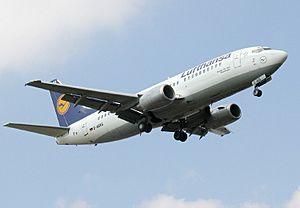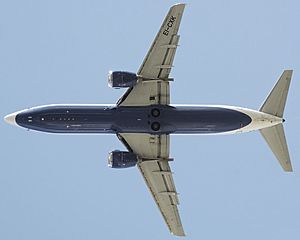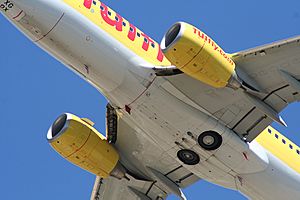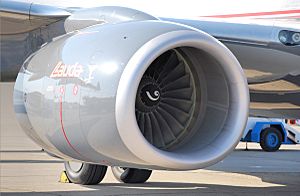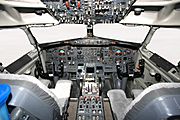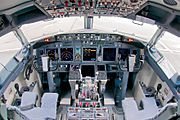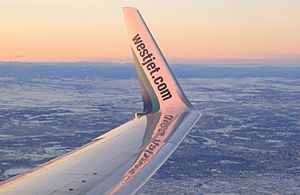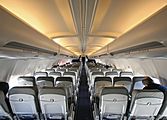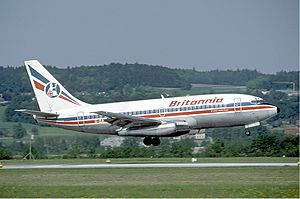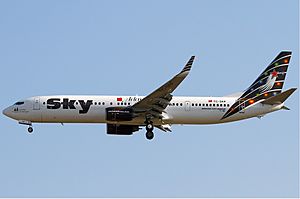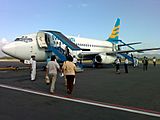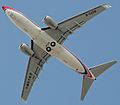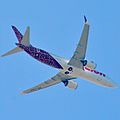Boeing 737 facts for kids
Quick facts for kids Boeing 737 |
|
|---|---|
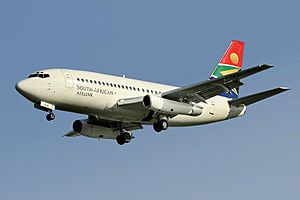 |
|
| A Boeing 737-200, the first mass-produced 737 model, in operation with South African Airways in 2007 | |
| Role | Narrow-body jet airliner |
| National origin | United States |
| Manufacturer | Boeing Commercial Airplanes |
| First flight | April 9, 1967 |
| Introduction | February 10, 1968, with Lufthansa |
| Status | In service |
| Primary users | Southwest Airlines Ryanair United Airlines American Airlines |
| Produced | 1966–present |
| Number built | 10,444 as of December 2018 |
| Unit cost | -100: US$3.7M (1968), $31.1M today -200: US$4.0M (1968), $33.7M today -200: US$5.2M (1972), $36.4M today |
| Variants | Boeing T-43 |
| Developed into | Boeing 737 Classic Boeing 737 Next Generation Boeing 737 MAX |
The Boeing 737 is a popular airplane built by Boeing. It has two jet engines and a narrow body, meaning it's not super wide. Boeing first designed it to be a smaller and cheaper plane than its older models, the 707 and 727. But the 737 grew into a huge family of nine different models! These planes can carry anywhere from 85 to 215 passengers. Today, the 737 is the only narrow-body jet that Boeing still makes.
Boeing started designing the 737 in 1964. The very first 737-100 flew in 1967. An airline called Lufthansa first used it for flights in February 1968. Later, Boeing made longer versions like the 737-200. In the 1980s, Boeing created the 737 Classic series, which included the -300, -400, and -500 models. These planes could carry more people and had new, quieter engines.
In the 1990s, Boeing launched the 737 Next Generation (NG) planes. These had even better wings, a modern cockpit, and a new cabin design. The 737 Next Generation includes the -600, -700, -800, and -900ER models. They range in length from about 102 ft (31.09 m) to 138 ft (42.06 m). A newer version, the 737 MAX, started flying in 2017 but was temporarily stopped in 2019 to make sure it was safe.
The 737 is the best-selling jet airliner ever! Boeing has been building 737s non-stop since 1967. Over 7,200 have been delivered, and many more are still on order. These planes are built at the Boeing Renton Factory in Renton, Washington. The main competitor for the 737 is the Airbus A320 family. It's amazing to think that, on average, 1,250 Boeing 737s are flying at any moment, and one takes off or lands somewhere in the world every five seconds!
How the 737 Was Developed
Starting the Design
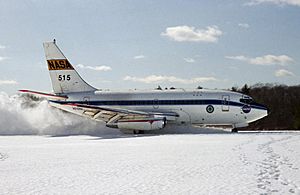
Boeing wanted to create a new plane for shorter flights, like a replacement for the 727. They started designing the 737 on May 11, 1964. After talking to airlines, Boeing learned that companies wanted a plane that could hold 50 to 60 passengers and fly distances of 50 to 1,000 mi (80 to 1,609 km).
Lufthansa was the very first airline to order the Boeing 737. They placed an order for 21 planes on February 19, 1965. After more discussions with Lufthansa, Boeing decided to make the 737 bigger so it could hold 100 passengers.
On April 5, 1965, United Airlines ordered 40 737s. United wanted a slightly larger plane than the original design. So, Boeing created a longer version called the 737-200. The first, shorter design was then named the 737-100.
Building and Testing the First 737s
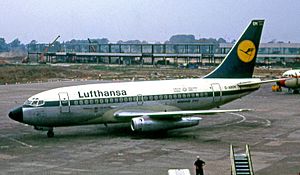
The first 737s were built near Boeing Field (now King County International Airport). This was because the main factory in Renton was busy building other planes like the 707 and 727. In 1970, after 271 planes were made, 737 production moved to Renton.
The first Boeing 737-100 prototype was ready in 1966. It made its first flight on April 9, 1967. The Federal Aviation Administration (FAA) approved it for passenger flights on December 15, 1967. Lufthansa received its first 737 on December 28, 1967. On February 10, 1968, Lufthansa became the first airline outside of the U.S. to fly a new Boeing plane. Only 30 of the 737-100s were ever made.
The 737-200 first flew on August 8, 1967. The FAA approved it on December 21, 1967. United Airlines used it for the first time on April 28, 1968, flying from Chicago to Grand Rapids, Michigan. Airlines liked the 737-200 much more than the shorter 737-100.
The 737-200 Advanced
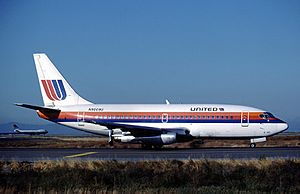
Early 737s had some issues with their "thrust reversers." These parts of the engine help slow the plane down after landing by pushing air forward. Boeing improved these in 1968, and the changes were added to all planes built after March 1969. Older planes could also get the upgrade.
Boeing also made the flaps better. Flaps are parts of the wing that help the plane take off and land. These improvements meant the 737 could carry more cargo and fly further. In May 1971, after the 135th plane was built, all these changes, plus better engines and more fuel, were added to the 737-200. This new version was called the 737-200 Advanced. It could carry 15% more weight and fly further than the first 737-200s.
In 1970, Boeing only received 37 orders for 737s. The company was low on money and even thought about stopping 737 production. But by canceling other projects and reducing the number of Boeing 747s they made, Boeing saved enough money to keep the 737 going.
Boeing stopped making 737-200s in 1988. A total of 1,114 were built, with the last one delivered to Xiamen Airlines on August 8, 1988.
The 737 Classic Series
In 1979, Boeing started working on a big upgrade for the 737. They wanted the plane to carry more passengers and fly longer distances. They also wanted to make it more modern while keeping it similar to older 737s. In 1980, they shared details about this new type, called the 737-300, at the Farnborough Airshow.
The CFM56-3B-1 engine was chosen for this new 737. This engine used much less fuel and was quieter. However, it was tricky to fit because the 737's wings are not very high off the ground, and the CFM56 engine was larger than the original engines. Boeing and CFM solved this by placing the engine slightly ahead of the wing instead of directly underneath. They also moved some engine parts that would normally be at the bottom to the sides. This made the engine look a bit like a "hamster pouch" because it wasn't perfectly round.
The plane's body (called the fuselage) was made bigger to hold 149 passengers. Many changes were also made to the wings. The wingtip was made longer, and the overall wingspan was increased. The cockpit was improved with electronic displays, though airlines could choose older ones. The passenger cabin was also made better, similar to the Boeing 757. The first 737-300 prototype flew on February 24, 1984.
In June 1986, Boeing announced the 737-400. This plane had an even longer fuselage (by 10 ft (3.0 m)) and could carry 170 passengers. The 737-400 first flew on February 19, 1988. Piedmont Airlines was the first to use it.
Boeing also made a 737-500 because customers wanted a modern replacement for the older 737-200. The -500 is a bit longer than the 737-200 and can carry up to 132 passengers. It could also have the new electronic cockpit.
Southwest Airlines first ordered the 737-500 in 1987. It flew for the first time on June 30, 1989. Southwest Airlines received their first one on February 28, 1990.
After the Boeing 737 Next Generation planes came out, Boeing officially named the 737-300, -400, and -500 models the 737 Classic series.
The 737 Next Generation (NG)
In 1991, Boeing started working on another updated group of 737s. They wanted to compete with the Airbus A320 family. On November 17, 1993, Boeing announced the 737 Next Generation (NG) program. The -600, -700, -800, and -900 models are all part of this program. The 737 was changed so much for the NG series that it was almost like a brand new plane, but some key parts were kept similar.
The wing was changed again, becoming 16 ft (4.9 m) wider. This allowed the plane to carry 30% more fuel. Newer, quieter CFM56-7B engines were used, which burned less fuel. All these improvements meant the 737NG could fly 900 nautical miles further, reaching over 3,000 nautical miles (5,600 km) in total. This allowed the 737NG to fly between different continents. Many 737NG models can also have winglets added to the ends of their wings. The cockpit got modern electronics (called avionics), and the passenger cabin was also improved.
The first NG plane built was a 737-700. It was finished on December 8, 1996, and flew for the first time on February 9, 1997. The prototype 737-800 was finished on June 30, 1997, and first flew on July 31, 1997. The smallest NG, the -600, is the same size as the -500. It was launched in December 1997 and first flew on January 22, 1998. The FAA approved it on August 18, 1998.
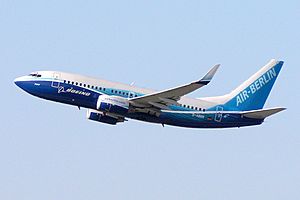
Boeing delivered its 5,000th 737 to Southwest Airlines on February 13, 2006. The 6,000th 737 went to Norwegian Air Shuttle in April 2009. The Next Generation series helped the 737 remain the best-selling airliner family since it first flew.
The 737 MAX
Since 2006, Boeing had been thinking about replacing the 737 with a completely new design. On July 20, 2011, Boeing announced they were working on a new 737 version with the new CFM International LEAP engine. American Airlines quickly ordered 100 of these planes. On August 30, 2011, Boeing confirmed the new plane, calling it the 737 MAX. It would use CFM International LEAP-1B engines.
The MAX 8 first carried passengers in May 2017. However, in 2019, two MAX 8 aircraft crashed, leading aviation authorities to temporarily stop all commercial flights of the 737 MAX until safety updates were made.
How the 737 is Designed
The 737's main landing gear (wheels) tuck into special holes at the bottom of the plane. Unlike many other planes, these wheels don't have doors that close over them. So, you can easily see the tires when a 737 is taking off or flying low.
737s do not have "fuel dump systems." A fuel dump system helps a plane get rid of extra fuel quickly if it needs to make an emergency landing while still very heavy. This is important because planes can only land safely below a certain weight. The first 737s were too small to need these systems. Adding one to bigger 737s would make the plane much heavier. Instead, if there's a non-urgent emergency, 737s fly in circles to burn off fuel. If the emergency is serious, the plane might land at a heavier weight, and then it needs to be checked for any damage.
Engines
The engines on the 737 Classic series (300, 400, 500) and Next Generation series (600, 700, 800, 900) are not shaped like a perfect circle, unlike most planes. The 737 Classics used CFM56 turbofan engines. These engines used much less fuel and were quieter than the older Pratt & Whitney JT8D engines used on the -100 and -200.
Because the 737's wings and body are not very high off the ground, it was hard to fit the large CFM56 engines. Boeing and CFM solved this by placing the engines slightly ahead of the wings instead of directly underneath. They also moved some engine parts that would normally be at the bottom to the sides. This is why the engines have their unique non-circular shape.
The gearbox of the engine was moved from the bottom to the side. This makes the engine look a bit like a triangle. Since the engine is close to the ground, it could be damaged by things on the runway. The CFM56-7 engine on the 737 Next Generation uses even less fuel than the engines on the 737 Classics. The Boeing 737 MAX planes will have CFM International LEAP-1B engines, which are designed to use 10-12% less fuel than the CFM56-7B engines.
Flight Systems
The 737's controls are designed to be very safe. If the hydraulic systems or both engines fail, small hinges called "servo tabs" will automatically help move important parts of the aircraft. These tabs are controlled by the yoke (the steering wheel for the plane). For the 737 Next Generation, a new cockpit with LCD screens was created. These cockpits also have modern avionics (like autopilot systems).
Most older 737 cockpits have "eyebrow windows." These are smaller windows above the main ones, two on each side. They were used on the Boeing 707 to help pilots see better when turning. However, with modern autopilot and radar systems, they are no longer needed. They were removed from the 737 cockpit in 2004. But 737s used by the military still have them, and Boeing can add them for customers who want them.
Upgrades
Winglets can be added to 737s that don't have them, or they can be installed when the plane is built. These winglets are about 8 feet (2.4 m) tall and are fitted at the end of the wing. They help the engines use less fuel by reducing "drag" (air resistance). They also help make less noise during takeoff. Winglets can help a plane save up to 5% on fuel.
As of 2008, the 737 can have carbon brakes made by Messier-Bugatti. These new brakes are much lighter, weighing 550–700 lb (250–320 kg) less than the usual steel brakes on the 737 Next Generation family. If a Boeing 737-800 loses 700 pounds of weight, it uses 0.5% less fuel.
Main Cabin
The look of the passenger cabin changed with each new type of 737. The original 737 cabin was updated for the 737 Classic using designs from the 757. Then, designs from the Boeing 777 were used for the Next Generation 737 cabin. The newest cabin design is called the Sky Interior. It has curved walls and redesigned windows. The Sky Interior offers more headroom and special LED mood lighting. It also has overhead bins that move, similar to those on a 777 and Boeing 787 Dreamliner. These bins have more space for luggage. The Sky Interior also makes the cabin quieter by 2–4 dB. The first 737 with the Sky Interior was delivered to Flydubai in 2010.
Types of Boeing 737s
The 737 planes are divided into three "generations": Original, Classic, and Next Generation. The "Original" models are the 737-100 and 737-200 (including the -200 Advanced). The "Classic" models are the 737-300, 737-400, and 737-500. The "Next Generation" models are the 737-600, 737-700 (and -700ER), 737-800, and 737-900 (and -900ER).
The fourth generation of the 737 is called the 737 MAX. It includes the 737-MAX-7, 737-MAX-8, and 737-MAX-9. The MAX-7 will replace the 737-700, the MAX-8 will replace the 737-800, and the MAX-9 will replace the 737-900 and 739-900ER.
737 Original Models
737-100
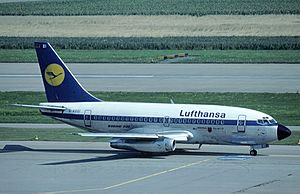
The very first 737 model was the 737-100. Lufthansa ordered it in 1965. The -100 was completed on January 17, 1967, and started flying passengers in 1968. This is the smallest type of 737. Only 30 737-100s were ever ordered and delivered. None of these planes are still used by airlines today. The original 737-100 prototype is now in the Museum of Flight in Seattle.
737-200
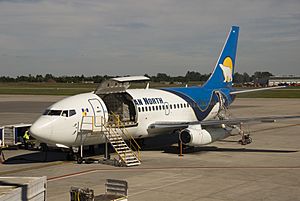
The 737-200 is a 737-100 with a longer body (called a fuselage). It was created because United Airlines placed an order for a larger plane in 1965. The -200 was finished on June 29, 1967, and began service in 1968. The 737-200 Advanced is an improved version of the -200. Its first user was All Nippon Airways, starting on May 20, 1971. The -200 Advanced had many improvements, like more powerful engines and more fuel, allowing it to fly further. The last 737-200 was delivered in August 1988 to Xiamen Airlines. Many 737-200s are still used by airlines today.
After 40 years, the last 737-200 aircraft in the United States were retired on March 31, 2008. This happened with the final flights of Aloha Airlines.
737 Classic Models
The Boeing 737 Classic is the name given to the 737-300, -400, and -500 models. They were only called "Classic" after the newer 737 Next Generation planes (737-600/700/800/900) were made. Before that, they were known as the "new generation" of the 737. The 737 Classics were built from 1984 to 2000. During that time, 1,988 planes were delivered. As of January 1, 2001, 1,945 of them were still flying.
737-300
The 737-300 began service in 1981. Both US Airways and Southwest Airlines used it. The 737-300 is the first model in the 737 Classic series. It can usually hold 128 passengers. The 737-300 series was made until 1999. The last -300 was delivered to Air New Zealand on December 17, 1999. This was the 1,113th 737-300 built.
737-400
The 737-400 started service in 1985. It was simply a longer version of the 737-300. Piedmont Airlines was the first customer, ordering 25 planes in 1986. The first 737-400s began flying with Piedmont in 1988. The last -400 was delivered to CSA Czech Airlines. This was the 486th -400 built.
The 737-400F was a 737-400 that was changed into a cargo plane. Boeing did not deliver the -400F directly; airlines converted them themselves. Alaska Airlines was the first airline to change a -400 into a -400F. It could carry 10 pallets of cargo.
737-500
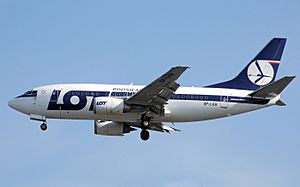
The 737-500 was completed in 1987. It began service with Southwest Airlines in 1990. The 737-500 is about the same length as the 737-200. It was a modern replacement for the 737-200. The last 737-500 was delivered to All Nippon Airways on July 26, 1999. This was the 389th one built.
737 Next Generation Models
In the 1990s, Boeing realized that the Airbus A320 family was a serious competitor. To avoid losing customers, Boeing started the Next Generation program in November 1993. The Next Generation planes were designed to replace the 737 Classics. The 737-600, 737-700, and 737-800 planes were planned.
737-600
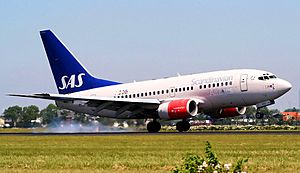
The 737-600 replaced the 737-500. It was also meant to replace the McDonnell Douglas DC-9. The 737-600 was finished in 1995. The first plane was delivered to Scandinavian Airlines on September 18, 1998. The 737-600 is the only Boeing 737 still being made that cannot have winglets added.
The 737-600 competes with planes like the Airbus A318, Embraer 195, and Sukhoi Superjet 100. The Bombardier CSeries will also be a competitor. As of 2010, 69 -600s have been delivered, and there are no more orders waiting.
737-700
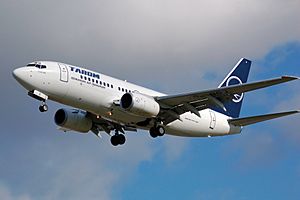
The 737-700 was added to the Next Generation planes when Southwest Airlines ordered one in November 1993. The -700 was based on the 737-300. It started service in 1998 and replaced the 737-300. Its main competitor is the A319. A 737-700 can hold 126 people with two classes (first class and economy) or 149 people if it only has economy class.
Boeing launched the 737-700ER on January 30, 2006. "ER" means "extra range," so this plane can fly further than a normal 737-700. All Nippon Airways was the first customer for the -700ER. It has the body of a 737-700 but the wings and landing gear of a 737-800. It can fly for 5,510 nautical miles (10,205 kilometers) and carry 126 passengers.
In July 2008, Delta Air Lines received the first -700 that had Messier-Bugatti's carbon brakes.
737-800
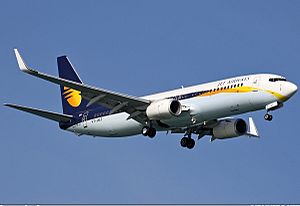
The 737-800 is a longer version of the 737-700. It replaces the 737-400. The -800 was finished in 1994. It started service with Hapag-Lloyd Flug (now TUIfly) in 1998. A 737-800 can hold 162 passengers with two classes or up to 189 passengers if it only has one class. Its main competitor is the A320.
737-900
The 737-900 is the longest 737. Alaska Airlines was the first customer for the 737-900 when it was launched in 1997. They received their first plane on May 15, 2001.
The 737-900ER is the newest and biggest Boeing 737. It was made to replace the 757-200 and compete with the Airbus A321. A 737-900ER can carry 180 passengers with two classes or 215 passengers if it only has one class. The -900ER can carry more fuel and has winglets. It can fly for about 3200 nautical miles. Boeing no longer makes the regular 737-900; they only make the 737-900ER now.
737 MAX Models
In 2011, Boeing announced the 737 MAX program. Boeing plans to make three types of 737 MAX: the MAX-7, MAX-8, and MAX-9. The MAX-7 will replace the 737-700, the MAX-8 will replace the 737-800, and the MAX-9 will replace the 737-900ER. The 737 MAX will have CFM International LEAP-1B engines. The wheel in the nose of the plane has been made longer. Deliveries were supposed to start in 2017. Southwest Airlines became the first customer on December 13, 2011. Lion Air and other airlines have also ordered 737 MAX planes.
Who Uses the 737?
The 737 is used by more than 500 airlines! These planes fly to 1,200 places in 190 countries. Over 10,000 737s have been ordered by airlines, and 7,283 have been delivered. More than 4,500 are still flying today. On average, there are always 1,250 737s in the air. This means a 737 takes off or lands every five seconds! About 25% of all the jet airliners in the world are Boeing 737s.
Airlines
As of July 2010, 383 Boeing 737-200s were still being used by airlines.
Military Use
Many countries use the 737 as a military plane. Some countries that use 737s are:
Orders and Deliveries
Total Planes Built
Over 7,400 Boeing 737s have been built and delivered. This information is correct as of December 31, 2012.
| 2012 | 2011 | 2010 | 2009 | 2008 | 2007 | 2006 | 2005 | 2004 | 2003 | 2002 | 2001 | 2000 | 1999 | 1998 | 1997 | 1996 | 1995 | 1994 | 1993 | 1992 | 1991 | 1990 | 1989 |
|---|---|---|---|---|---|---|---|---|---|---|---|---|---|---|---|---|---|---|---|---|---|---|---|
| 415 | 372 | 376 | 372 | 290 | 330 | 302 | 212 | 202 | 173 | 223 | 299 | 281 | 320 | 281 | 135 | 76 | 89 | 121 | 152 | 218 | 215 | 174 | 146 |
| 1988 | 1987 | 1986 | 1985 | 1984 | 1983 | 1982 | 1981 | 1980 | 1979 | 1978 | 1977 | 1976 | 1975 | 1974 | 1973 | 1972 | 1971 | 1970 | 1969 | 1968 | 1967 |
|---|---|---|---|---|---|---|---|---|---|---|---|---|---|---|---|---|---|---|---|---|---|
| 165 | 161 | 141 | 115 | 67 | 83 | 95 | 108 | 92 | 77 | 40 | 25 | 41 | 51 | 55 | 23 | 22 | 29 | 37 | 114 | 105 | 4 |
Number of Each Type Built
As of December 2012, over 10,400 Boeing 737s have been ordered. About 3,020 planes still need to be delivered. Here's a list of how many of each 737 type have been built:
|
|
|
||||||||||||||||||||||||||||||||||||||||||||||||||||||||||||
This information comes from Boeing.com.
Safety Record
As of April 2012, the 737 has been involved in 315 "incidents." 159 of these were "hull loss accidents," meaning the plane was so damaged it couldn't be used anymore, or it was completely destroyed. Sadly, 4,236 people have died in these crashes. The 737 has also been part of 106 hijackings, where 324 people died.
Features of the 737
| 737-100 | 737-200 | 737-200 Advanced | 737 Classic (-300/-400/-500) | 737 Next Generation (-600/-700/-800/-900ER) | |
|---|---|---|---|---|---|
| Cockpit crew | Two pilots | ||||
| Number of passengers that can fly in the plane | 124 (maximum) 85 (usual) |
136 (maximum) 97 (usual) |
136 (maximum) 102 (usual) |
149 - 189 (maximum) 108 - 146 (usual) |
130 - 215 (maximum) 108 - 177 (usual) |
| Length | 94 ft (28.65 m) | 100 ft 2 in (30.53 m) | 102–120 ft (31–37 m) | 102–138 ft (31–42 m) | |
| Area of the wing | 102.0 m2 (1,098 sq ft) | 105.4 m2 (1,135 sq ft) | 124.58 m2 (1,341.0 sq ft) | ||
| Height | 36 ft 10 in (11.23 m) | 36 ft 4 in (11.07 m) | 41 ft 3 in (12.57 m) | ||
| Cruising speed | Mach 0.74 (485 mph, 780 km/h) | Mach 0.78 (511 mph, 823 km/h) | |||
| Top speed | Mach 0.82 (544 mph, 876 km/h) | ||||
| Ceiling (how high the plane can fly) | 35,000 ft (10,700 m) | 37,000 ft (11,300 m) | 41,000 ft (12,500 m) | ||
| Engines (×2) | Pratt & Whitney JT8D | CFM International 56-3 series | CFM International CFM56-7 series | ||
This information comes from: Boeing 737 specifications, 737 Airport Planning Report, b737.org.uk site.
Related Pages
- Aircraft related to this one
- Similar aircraft
- Anderson, David F. and Scott Eberhardt. Understanding Flight. Chicago: McGraw Hill Professional, 2009. ISBN: 978-0-07-162696-5.
- Bowers, Peter M. Boeing Aircraft since 1916. Annapolis, Maryland: Naval Institute Press, 1989. ISBN: 0-87021-037-8.
- Endres, Günter. The Illustrated Directory of Modern Commercial Aircraft. St. Paul, Minnesota: MBI Publishing Company, 2001. ISBN: 0-7603-1125-0.
- Redding, Robert and Bill Yenne. Boeing: Planemaker to the World. Berkeley, California: Thunder Bay Press, 1997. ISBN: 1-57145-045-9.
- Sharpe, Michael and Robbie Shaw. Boeing 737-100 and 200. St. Paul, Minnesota: MBI Publishing Company, 2001. ISBN: 0-7603-0991-4.
- Shaw, Robbie. Boeing Jetliners. London, England: Osprey, 1995. ISBN: 1-85532-528-4.
- Shaw, Robbie. Boeing 737-300 to 800. St. Paul, Minnesota: MBI Publishing Company, 1999. ISBN: 0-7603-0699-0.
- Sutter, Joe. 747: Creating the World's First Jumbo Jet and Other Adventures from a Life in Aviation. Washington, D.C.: Smithsonian Books, 2006. ISBN: 0-06-088242-5.
| Boeing 7x7 aircraft timeline, 1955–now | ||||||||||||||||||||||||||||||||||||||||||||||||||||||||||
|---|---|---|---|---|---|---|---|---|---|---|---|---|---|---|---|---|---|---|---|---|---|---|---|---|---|---|---|---|---|---|---|---|---|---|---|---|---|---|---|---|---|---|---|---|---|---|---|---|---|---|---|---|---|---|---|---|---|---|
| 1950s | 1960s | 1970s | 1980s | 1990s | 2000s | 2010s | ||||||||||||||||||||||||||||||||||||||||||||||||||||
| 1955 | 1956 | 1957 | 1958 | 1959 | 1960 | 1961 | 1962 | 1963 | 1964 | 1965 | 1966 | 1967 | 1968 | 1969 | 1970 | 1971 | 1972 | 1973 | 1974 | 1975 | 1976 | 1977 | 1978 | 1979 | 1980 | 1981 | 1982 | 1983 | 1984 | 1985 | 1986 | 1987 | 1988 | 1989 | 1990 | 1991 | 1992 | 1993 | 1994 | 1995 | 1996 | 1997 | 1998 | 1999 | 2000 | 2001 | 2002 | 2003 | 2004 | 2005 | 2006 | 2007 | 2008 | 2009 | 2010 | 2011 | 2012 | 2013 |
| Boeing 707 | ||||||||||||||||||||||||||||||||||||||||||||||||||||||||||
| Boeing 717 (MD-95) | ||||||||||||||||||||||||||||||||||||||||||||||||||||||||||
| Boeing 727 | ||||||||||||||||||||||||||||||||||||||||||||||||||||||||||
| Boeing 737 | ||||||||||||||||||||||||||||||||||||||||||||||||||||||||||
| Boeing 747 | ||||||||||||||||||||||||||||||||||||||||||||||||||||||||||
| Boeing 757 | ||||||||||||||||||||||||||||||||||||||||||||||||||||||||||
| Boeing 767 | ||||||||||||||||||||||||||||||||||||||||||||||||||||||||||
| Boeing 777 | ||||||||||||||||||||||||||||||||||||||||||||||||||||||||||
| Boeing 787 | ||||||||||||||||||||||||||||||||||||||||||||||||||||||||||
| = Not being made anymore | = Still being made | |||||||||||||||||||||||||||||||||||||||||||||||||||||||||
Images for kids
-
The 737-200 was brought into service by United Airlines on April 28, 1968.
-
737-300 with wider CFM56 turbofans, introduced by USAir on November 28, 1984.
-
Shorter by 2.4 m (7 ft 10 in), the first 737-500 was delivered to Southwest Airlines on February 28, 1990.
-
The first 737-900 was delivered to Alaska Airlines on May 15, 2001.
-
The T-43 was a 737-200 used by the United States Air Force to train navigators.
-
The Boeing C-40 Clipper is a military version of the 737-700C.
-
The P-8 Poseidon is a 737-800 variant for anti-submarine warfare, anti-surface warfare, and shipping interdiction.
-
United Airlines Airbus A320 (front) and Boeing 737-900 on final approach.
-
The largest 737 operator is Southwest Airlines.
-
USAir 737-200 fuselage section at the Museum of Flight.
-
The 737NG with improved CFM56-7 engines.
-
The 737 MAX has larger CFM LEAP engines with chevrons.
See also
 In Spanish: Boeing 737 para niños
In Spanish: Boeing 737 para niños



